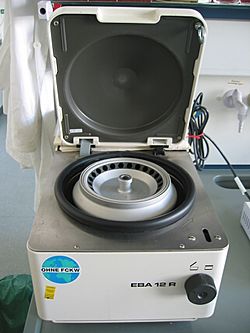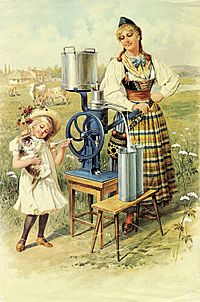Centrifuge facts for kids

A centrifuge is a piece of equipment that puts an object in rotation around a fixed axis (spins it in a circle), applying a potentially strong force perpendicular to the axis of spin (outward). The centrifuge works using the sedimentation principle, where the centripetal acceleration causes denser substances and particles to move outward in the radial direction. At the same time, objects that are less dense are displaced and move to the center. In a laboratory centrifuge that uses sample tubes, the radial acceleration causes denser particles to settle to the bottom of the tube, while low-density substances rise to the top.
There are 3 types of centrifuge designed for different applications. Industrial scale centrifuges are commonly used in manufacturing and waste processing to sediment suspended solids, or to separate immiscible liquids. An example is the cream separator found in dairies. Very high speed centrifuges and ultracentrifuges able to provide very high accelerations can separate fine particles down to the nano-scale, and molecules of different masses.
Large centrifuges are used to simulate high gravity or acceleration environments (for example, high-G training for test pilots). Medium-sized centrifuges are used in washing machines and at some swimming pools to wring water out of fabrics.
Gas centrifuges are used for isotope separation, such as to enrich nuclear fuel for fissile isotopes.
Contents
History
English military engineer Benjamin Robins (1707–1751) invented a whirling arm apparatus to determine drag. In 1864, Antonin Prandtl proposed the idea of a dairy centrifuge to separate cream from milk. The idea was subsequently put into practice by his brother, Alexander Prandtl, who made improvements to his brother's design, and exhibited a working butterfat extraction machine in 1875.
Types
A centrifuge machine can be described as a machine with a rapidly rotating container that applies centrifugal force to its contents. There are multiple types of centrifuge, which can be classified by intended use or by rotor design.
- a uranium centrifuge is used to separate two isotopes of uranium (named U-235 and U-238) from each other;
- in medical laboratories, serum is separated from the blood samples using a centrifuge;
- in chemical laboratories, centrifuges are used to subtract solid parts of an emulsion from its liquid parts.
- huge centrifuges are used by NASA to expose astronauts to high forces for their training.
Images for kids
See also
 In Spanish: Centrifugadora para niños
In Spanish: Centrifugadora para niños





